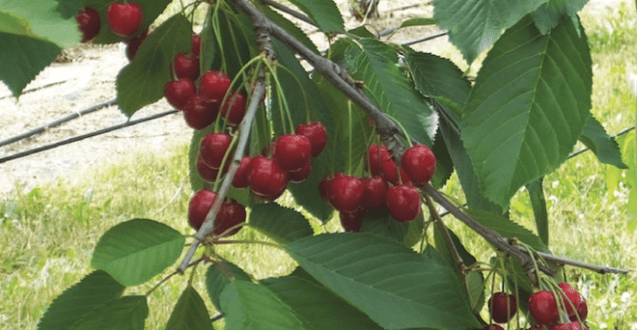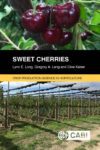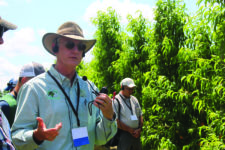
Feb 4, 2021Sweet cherry evolution a decades-long journey
This is the first in a series of stories that marks the 60th anniversary of Fruit Growers News.
The evolution of sweet cherry production has brought together three recognized aficionados on the topic, reflecting on how the commodity has progressed over several decades, and documenting successful cropping strategies being pursued now and into the future.
Lynn Long, retired professor and an Extension horticulturist at Oregon State University (OSU); Gregory Lang, professor of tree fruit physiology at Michigan State University and program leader for the stone fruit physiology laboratory; along with Clive Kaiser, professor at OSU and interim director of the the Hermiston Agricultural Research & Extension Center, have written a new book, “Sweet Cherries.”
The heavily-illustrated book has been published by CABI, an international, inter-governmental, nonprofit organization that applies scientific expertise to solve problems in agriculture and the environment. The book is the latest in CABI’s Crop Production Science in Horticulture series.
This new book provides comprehensive coverage of the history, genetic improvements, production physiology of growth and cropping, orchard establishment and management, and harvest considerations for sustainable cherry production. Sweet cherries are a specialty crop, subject to significant production risks for growers, yet with high potential market returns due to strong consumer demand for the fruit’s intensely enjoyable flavor and nutraceutical benefits.
A

“I’ve been working on this book for several years with my co-authors,” Lang told Fruit Grower News. “Though delayed a bit by COVID, it is now finally available. The book is geared to growers, consultants, Extension educators and students, as well as fruit scientists, and is very reasonably priced for access to all. This is the culmination of at least 10 years of ‘pressure’ from growers to put together a comprehensive, practical, up-to-date guide to growing cherries.”
A process of development
“Sweet cherry production was pretty static for decades during the last century, with only the occasional new variety creating a minor ripple in the status quo,” Lang said. “The introduction of ‘Lapins’ as a high quality, self-fertile variety in the 1980s started the rise of production by increasing yield consistency year-in and year-out and serving as a parent for future important new self-fertile varieties.
“In the 1990s, a range of precocious, vigor-reducing rootstocks was introduced, with the Gisela series being the most successful,” Lang said. “This initiated significant physiological research to understand how to utilize these new traits, resulting in the breaking of many old paradigms for how cherry trees should be managed. This, in turn, led to the development or refinement of an increasing number of innovative tree training systems in the 2000s, and also helped to facilitate orchards that could more readily be covered by rain protection systems like high tunnels, reducing losses to rain-cracking in non-arid growing regions.


“In the 2010s, the simplification of tree canopy architectures into narrow, repeatable fruit-bearing units is addressing increasing concerns about labor costs and availability by improving labor efficiencies and the potential for partial mechanization, while also increasing fruit quality,” Lang said.
“Sweet cherry production has changed and expanded as much or more than any other tree fruit over the past 20 years, with the advent of vigor-controlling rootstocks, new training systems, orchard rain-covering structures and a continuously strong worldwide market, so our goal was to summarize all that has been learned by growers and scientists into a single comprehensive reference,” Lang said.
“I anticipate that one of the key trends of the 2020s will be the increasing adoption of sensing technologies and data acquisition to improve orchard management decisions that would have been impossible in the low density, large chaotic tree canopy orchards of the last century. You can see how each major advance in cherry production has built upon the previous breakthrough.”
Top take-home messages Lang outlined the top three emphasis areas coming from the book:
• Understand what is your most valuable accessible market (and anticipate its future over the life of the orchard), because that will dictate the fruit yields and quality that you need to strive to produce, and the most appropriate subsequent investments in plant materials, production systems and technologies, and labor efficiencies.
• Understand cherry tree growth and fruiting, so that your orchard management decisions optimize those natural traits to achieve your market and labor goals.
• If possible, devote a small portion of your orchard to test promising new varieties, new rootstocks and new training ideas that you learn about through this book, fruit-growing magazines, internet sources, fruit grower conferences, nursery catalogs, etc.
“We are hopeful that the approach we took in the book will serve not simply as ‘recipes’ to follow, but to help growers evaluate what their specific orchard and market needs are, and consider what the most appropriate solutions may be that will help them sustain short- and long-term profitability,” Lang said.
What’s ahead for the industry
“Sensing technologies that will facilitate improvements in irrigation, plant stress reduction, pest management, crop load estimation and modification; better tools to manage the effects of an increasing climatic extremes; and increased partial mechanization to reduce labor inefficiencies are likely areas for advancement in the coming decade,” Lang said.
RELATED: Fruit Growers News: 60 years and counting
“Sweet Cherries” is written with practical details and underlying physiological concepts for use by beginning and established fruit growers, consultants, and advisors, with a primary focus on fresh market sweet cherries, in addition to students and professionals in horticulture. In the Americas, the $60 book is available from Stylus Publishing.
— Gary Pullano, Editor














